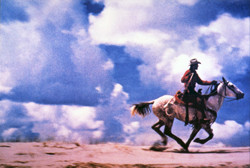Richard Prince
28 Sep 2007 - 09 Jan 2008

Richard Prince, Untitled (cowboy) , 1989. Ektacolor photograph. Edition of 1, 127 x 177.8 cm. Metropolitan Museum of Art, New York, Purchase, The Horace W. Goldsmith Foundation and Jennifer and Joseph Duke Gifts, 2000. © Richard Prince
Richard Prince: Spiritual America
September 28, 2007–January 9, 2008
This critical overview of Richard Prince's career is the most comprehensive examination of the celebrated American artist's work to date. The exhibition highlights Prince's contributions to the development of contemporary art, bringing together key examples of his photographs, paintings, sculptures, and works on paper in an installation that integrates the various series comprising his oeuvre.
Prince's work has been among the most innovative art produced in the United States during the past 30 years. His deceptively simple act in 1977 of rephotographing advertising images and presenting them as his own ushered in an entirely new, critical approach to art-making—one that questioned notions of originality and the privileged status of the unique aesthetic object. Prince's technique involves appropriation; he pilfers freely from the vast image bank of popular culture to create works that simultaneously embrace and critique a quintessentially American sensibility: the Marlboro Man, muscle cars, biker chicks, off-color jokes, gag cartoons, and pulp fiction. While previous examinations of his art have emphasized its central role as a catalyst for postmodernist criticism, the Guggenheim exhibition and its accompanying catalogue also focus on the work's iconography and how it registers prevalent themes in our social landscape, including a fascination with rebellion, an obsession with fame, and a preoccupation with the tawdry and the illicit.
Organized by Nancy Spector, Chief Curator, in close collaboration with the artist, the exhibition brings together key examples from the numerous series comprising Prince's oeuvre, including early appropriated photographs, as well as photographic series, such as Cowboys, Girlfriends and Upstates; painted canvases such as Jokes, White Paintings, Check Paintings, and Nurses; and the Hood sculptures. Long interested in the display of his work as part of his overall conceptual practice, Prince has a history of creating special environments for his art. His exhibition at the Guggenheim follows suit, allowing him to present a summation of his achievements to date in an installation that fills the entire Frank Lloyd Wright rotunda and two adjacent galleries, interspersing works of various dates and mediums.
www.guggenheim.org
September 28, 2007–January 9, 2008
This critical overview of Richard Prince's career is the most comprehensive examination of the celebrated American artist's work to date. The exhibition highlights Prince's contributions to the development of contemporary art, bringing together key examples of his photographs, paintings, sculptures, and works on paper in an installation that integrates the various series comprising his oeuvre.
Prince's work has been among the most innovative art produced in the United States during the past 30 years. His deceptively simple act in 1977 of rephotographing advertising images and presenting them as his own ushered in an entirely new, critical approach to art-making—one that questioned notions of originality and the privileged status of the unique aesthetic object. Prince's technique involves appropriation; he pilfers freely from the vast image bank of popular culture to create works that simultaneously embrace and critique a quintessentially American sensibility: the Marlboro Man, muscle cars, biker chicks, off-color jokes, gag cartoons, and pulp fiction. While previous examinations of his art have emphasized its central role as a catalyst for postmodernist criticism, the Guggenheim exhibition and its accompanying catalogue also focus on the work's iconography and how it registers prevalent themes in our social landscape, including a fascination with rebellion, an obsession with fame, and a preoccupation with the tawdry and the illicit.
Organized by Nancy Spector, Chief Curator, in close collaboration with the artist, the exhibition brings together key examples from the numerous series comprising Prince's oeuvre, including early appropriated photographs, as well as photographic series, such as Cowboys, Girlfriends and Upstates; painted canvases such as Jokes, White Paintings, Check Paintings, and Nurses; and the Hood sculptures. Long interested in the display of his work as part of his overall conceptual practice, Prince has a history of creating special environments for his art. His exhibition at the Guggenheim follows suit, allowing him to present a summation of his achievements to date in an installation that fills the entire Frank Lloyd Wright rotunda and two adjacent galleries, interspersing works of various dates and mediums.
www.guggenheim.org
